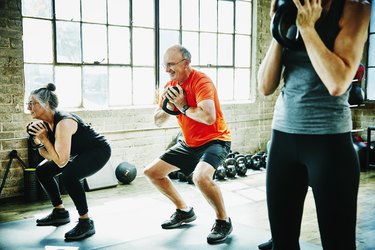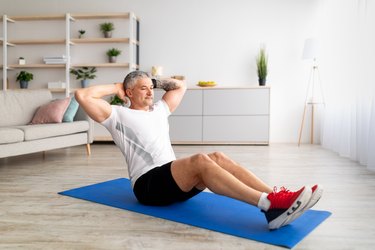
No matter your age, you can build muscle through regular exercise. Strength training is particularly beneficial as you get older because it helps stave off age-related muscle loss and promotes bone health.
Building muscle over 60, though, isn't going to be easy; be prepared to change your diet, commit to regular training and tweak your lifestyle habits.
Video of the Day
Video of the Day
How Muscle Changes as You Age
It's not your imagination: Muscle is harder to gain and maintain as you get older. In fact, it's so common, it even has a name: sarcopenia, or age-related muscle loss. After 30, you might lose as much as 5 percent of your muscle mass per decade, according to Harvard Health Publishing.
Some of this is due to hormone changes or other processes you can't control. But you can harness your exercise habits (and your diet) to help you stay strong.
Benefits of Building Muscle Over 60
Older adults who strength train are likely to live longer. In fact, people 65 and up who did strength training at least twice a week were 46 percent less likely to die of any cause than those who didn't lift, according to a June 2016 study in Preventive Medicine.
Strength training also stresses your bones (in a good way) that helps prevent losses in bone density that could progress to osteoporosis and make you more at risk of breaks and fractures, according to the National Library of Medicine.
Plus, building muscle and strength improves confidence, regulates muscle repair hormones and stimulates the brain, according to the American Council on Exercise (ACE), all important at any age, but especially after 60.
So how do you start building muscle after 60? Follow these tips.
Set Realistic Goals and Create a Plan
Rebuilding muscle mass after 60 takes time and discipline. Your body won't transform overnight. That's why it's important to set realistic goals and make lasting lifestyle changes.
Assess your current fitness level. If you're new to training or haven't exercised in years, focus on building up your strength and endurance.
If you're fairly active, you'll find it easier to commit to an exercise plan and build lean mass. Just make sure you have realistic goals. You may not be able to put on 5 pounds of muscle in three months, but you can definitely do it in a year or so. Stick to your workout, monitor your progress and make adjustments along the way.
Consider working with a certified personal trainer or other credentialed fitness expert who can help you set goals and create a safe and effective workout plan you're likely to stick to.
Your exercise routine should match your fitness level and align with your goals. To build muscle, prioritize strength training and full-body workouts.
Cardio training is important too: It supports your heart and boosts physical endurance, but it will deliver only limited muscle-building results.
Focus on Compound Exercises
Building muscle after 60 (or even older!) is easier if you know what to do in the gym. Exercise that engage more than one muscle group and joint, called compound movements, yield the best results in terms of building muscle.
Try movements like:
- Squats
- Bench presses
- Pull-ups
- Push-ups
- Dead lifts
- Lunges
As you grow comfortable with these movements, you'll eventually be able to lift heavier weights than you would when performing single-joint or isolation movements. And heavier resistance training results in greater strength gain than lighter weights, according to October 2015 research in the Journal of Strength and Conditioning Research.
Try to strength train at least twice a week on non-consecutive days, per the Physical Activity Guidelines for Americans. If you're more experienced with strength training, your plan might include more muscle-building workouts or sessions targeting specific muscle groups or areas of the body.
Not sure where to start? Try some of these workouts specifically designed for older adults.
Get Plenty of Rest
Weight training after 60 comes with its challenges, especially for those who haven't worked out in years. Any type of exercise, whether it's cardio or weightlifting, puts stress on your body and central nervous system, so you need to leave time for adequate rest.
Poor recovery can lead to muscle damage and injuries, according to the ACE. It also affects physical performance and interferes with the body's ability to replenish its energy stores. The more intense your workout, the more rest you need.
Don't work the same muscle group on back-to-back days, and leave at least one to two days for breaks from muscle-building workouts. Depending on your fitness and experience, you might do some cardio or active recovery on those days or you might take them completely off from exercise.
Massage, foam rolling, drinking plenty of water and stretching can all help improve muscle recovery. And prioritize at least seven hours of sleep a night to support recovery, too.
Eat for Your Goals
You can't build muscle with exercise alone — at any age. Your body needs enough protein from your diet to build the protein in your muscles. And your protein needs likely increase as you age.
The bare minimum amount of protein sedentary adults need each day is 0.8 grams per kilogram of body weight. But as you start to lose muscle mass with age, that jumps to 1 to 1.2 grams per kilogram of body weight, according to the Mayo Clinic. No matter your age, if you're lifting weights regularly, you probably actually need more like 1.2 to 1.7 grams per kilogram of your body weight.
To figure out your protein needs, divide your weight in pounds by 2.2, then multiply that number by 1.2. That will give you the minimum amount of protein to get each day if you're strength training regularly.
To meet that goal, focus on eating plenty of high-protein foods like lean meat, eggs, fish, cottage cheese, Greek yogurt, beans, lentils and quinoa.
- Preventive Medicine: "Is Strength Training Associated With Mortality Benefits?"
- Journal of Strength and Conditioning Research: "Effects of Low- vs. High-Load Resistance Training on Muscle Strength and Hypertrophy in Well-Trained Men"
- ACE: "The Science of Post-Exercise Recovery"
- Harvard Health Publishing: "Preserve your muscle mass"
- ACE: "Benefits of Resistance Training for Seniors"
- NLM: "Aging changes in the bones - muscles - joints"
- HHS: "Physical Activity Guidelines for Americans"
- Mayo Clinic: "Are you getting too much protein?"
- Help Guide: Senior Exercise and Fitness Tips
- Bodybuilding.com: What Is the Best Workout for People Over 60?




